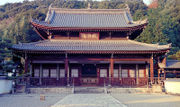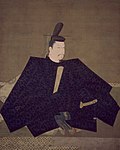East Asian Mādhyamaka (redirect from Sanron-shū)
Chinese Buddhism, these are often referred to as the Sānlùn (Ch. 三論宗, Jp. Sanron, "Three Treatise") school, also known as the "emptiness school" (K'ung Tsung)...
19 KB (2,514 words) - 22:11, 5 October 2024
Nagarjuna (category Sanron-shū)
Nagarjuna (Sanskrit: नागार्जुन, Nāgārjuna; c. 150 – c. 250 CE) was an Indian monk and Mahāyāna Buddhist philosopher of the Madhyamaka (Centrism, Middle...
46 KB (5,401 words) - 21:27, 15 October 2024
Asanga and Vasubandhu on mastering the consciousness and mind. Sanron Buddhism (三論宗, Sanron-shū), introduced to Japan around 625 by the Goguryeo monk Hyegwan...
99 KB (11,872 words) - 19:45, 12 October 2024
Nichiren-shū in Italy and Europe, website in Italian, English, French and Spanish Nichiren-shū in the UK Nichiren Shu in Hungary Nichiren Shu Brasil Nichiren...
19 KB (1,878 words) - 10:50, 27 June 2024
Daian-ji (category Sanron-shū)
34°40′05″N 135°48′46″E / 34.668°N 135.812722°E / 34.668; 135.812722 Daian-ji (大安寺) was founded during the Asuka period and is one of the Seven Great...
7 KB (582 words) - 12:42, 9 August 2024
Jodo Shinshu and the Ji-shū sects are considered different enough to be separate from Jodo-shū. The largest branch of Jōdo-shū, the Chinzei-ha (鎮西派, "The...
28 KB (3,393 words) - 15:22, 24 June 2024
Gangō-ji (category Sanron-shū)
Gangō-ji (元興寺) is an ancient Buddhist temple, that was once one of the powerful Seven Great Temples, in Nara, Japan. The original foundation of the temple...
5 KB (416 words) - 15:12, 23 September 2024
Mūlamadhyamakakārikā (category Sanron-shū)
who wrote a commentary on the Middle Treatise in Chinese, the Zhongguanlun shu (中觀論疏). Other surviving and influential Indian commentaries on the MMK include...
35 KB (3,632 words) - 10:42, 8 August 2024
Tattvasiddhi (redirect from Jōjitsu-shū)
Mādhyamaka instead of a separate lineage. East Asian Mādhyamaka (三論宗, Sanron-shū) was one of the six Nara sects (南都六宗, Nanto Rokushū). Sautrāntika Bahuśrutīya...
10 KB (1,329 words) - 15:38, 20 June 2023
Aryadeva (category Sanron-shū)
Āryadeva (fl. 3rd century CE) (IAST: Āryadeva; Tibetan: འཕགས་པ་ལྷ་, Wylie: 'phags pa lha, Chinese: 提婆 菩薩 Tipo pusa meaning Deva Bodhisattva), was a Mahayana...
13 KB (1,624 words) - 14:34, 21 June 2024
Higashi Hongan-ji Dobokai Ji-shū Yūzū-nembutsu-shū Risshū (Vinaya school) Jojitsu (Satyasiddhi – historical, syncretized with Sanron) Kusha (Abhidharmakośa...
42 KB (4,306 words) - 09:34, 20 September 2024
moral structure of their monks and nuns. East Asian Mādhyamaka (三論宗, Sanron-shū) (Mahayana)- Also known as the "Three Treatise School", this sect studied...
8 KB (778 words) - 02:02, 13 April 2024
based on the Madhyamaka school Chinese: 三論 sānlùn 三論宗 Cn: Sānlùnzōng Jp: Sanron-shū Vi: Tam luận tông sanzen A formal interview with a teacher in many traditions...
100 KB (940 words) - 01:29, 9 September 2024
Rinzai school (redirect from Rinzai-shu)
The Rinzai school (Japanese: 臨済宗, romanized: Rinzai-shū, simplified Chinese: 临济宗; traditional Chinese: 臨濟宗; pinyin: Línjì zōng), named after Linji Yixuan...
29 KB (3,401 words) - 02:19, 6 September 2024
including Shingon, Tendai, and the Nara temple schools such as Kegon, Hossō, Sanron, and Ritsu continued to thrive and adapt to the trend of the times.: 561–563 ...
24 KB (3,042 words) - 21:53, 15 August 2024
afterwards with a contingent of warrior monks from his own religious sect, Jōdo-shū, and, after defeating the Ikkō adherents in battle, burned all their temples...
15 KB (2,091 words) - 17:26, 1 June 2024
groups are commonly associated with Nichiren Shōshū and various Nichiren-shū schools. In addition, modern lay organizations not affiliated with temples...
119 KB (13,242 words) - 23:44, 29 August 2024
Chōnen (category Sanron Buddhist monks)
three scriptures brought to Japan by the Korean monk Ekwan in 625, the sanron-shū, under Kanri, a monk of Tônan-in (one of the many shrines that comprised...
4 KB (549 words) - 04:44, 16 November 2022
Tendai (天台宗, Tendai-shū), also known as the Tendai Lotus School (天台法華宗 Tendai hokke shū, sometimes just "hokke shū"), is a Mahāyāna Buddhist tradition...
67 KB (8,813 words) - 17:01, 23 September 2024
Pure Land Buddhism (section Hōnen's Jōdo-shū)
Pure Land institutions, as can be seen in the Jōdo-shū, Jōdo Shinshū, Yūzū-nembutsu-shū, and Ji-shū. These new Pure Land schools were part of a new wave...
159 KB (21,807 words) - 11:47, 18 October 2024
Hōnen (category Jōdo-shū)
many-recitation or Tanengi branch of Jōdo-shū. Chōsai (1184–1266), founder of the Shōgyōhongangi branch of Jōdo-shū which believed that all Buddhist practices...
22 KB (2,725 words) - 06:37, 31 August 2024
Japan Schools Jōjitsu Hosso Sanron Kegon Ritsu Kusha Tendai Shingon Jōdo-shū Jōdo Shinshū Rinzai Sōtō Nichiren Ōbaku Fuke-shū Shugendo Japanese new religions...
3 KB (296 words) - 01:53, 7 July 2024
the most prominent being Nichiren Shōshū and some lineages within Nichiren Shū. Nikkō kept meticulous records and highly organized religious practice during...
18 KB (2,247 words) - 07:58, 26 May 2023
Risshū (Buddhism) (redirect from Ritsu-shū)
Japan Schools Jōjitsu Hosso Sanron Kegon Ritsu Kusha Tendai Shingon Jōdo-shū Jōdo Shinshū Rinzai Sōtō Nichiren Ōbaku Fuke-shū Shugendo Japanese new religions...
2 KB (189 words) - 03:35, 11 May 2022
Japan Schools Jōjitsu Hosso Sanron Kegon Ritsu Kusha Tendai Shingon Jōdo-shū Jōdo Shinshū Rinzai Sōtō Nichiren Ōbaku Fuke-shū Shugendo Japanese new religions...
4 KB (333 words) - 04:20, 10 August 2024
back of statues. One collection of 100 poems is called, "Kesa Niji Hyaku Shu" (“One Hundred Poems Containing the Two Characters Kesa). The other which...
5 KB (605 words) - 03:37, 5 September 2022
Japan Schools Jōjitsu Hosso Sanron Kegon Ritsu Kusha Tendai Shingon Jōdo-shū Jōdo Shinshū Rinzai Sōtō Nichiren Ōbaku Fuke-shū Shugendo Japanese new religions...
7 KB (959 words) - 13:02, 16 January 2023






















